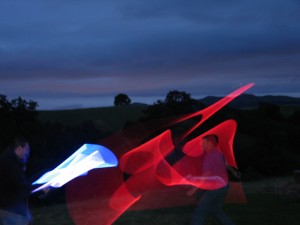Late, of course. I swear I don’t know how regular bloggers manage to keep up the volume.
Anyway, the weekend was mostly a ball, modulo getting hammered by something that could be a bug, but is likely as not just a bad case of seasonal allergies.
On Saturday, I attended the Maker Faire, where a tremendous amount of cool stuff was on display. TechShop had almost an entire hall — one of the smaller ones, but still — to itself, with a bunch of machines in operation. The laser engravers were almost hypnotic to watch, as their flying heads burned crisp, variable-depth designs into sheets of wood band by precise band.
The plasma-arc cutter, meanwhile, bordered on intimidating: I watched it cut copies of TechShop’s gear-wheel logo out of eighth-inch steel as easily as an X-Acto knife slices dolls out of paper. When I remarked how fast it was, the woman exhibiting it informed me with just a trace of glee that its top speed was considerably higher still.
I strongly suspect that I’ll become a TechShop member in the not-too-distant future.
I’d been eyeing the Make Controller Kit with an even mix of curiosity and desire for a while, but deterred by the long backlog from actually taking the plunge and ordering one. However, the sight of several dozen, stacked in unassuming cardboard boxes at the Maker Store, just waiting to be purchased, proved to be more than a match for my limited reserves of self-restraint.
It should come in handy as I ramp up on mucking around with DIY sabersmithy — I have some ideas involving sensors and color-modulated RGB LEDs that won’t get very far at all without some kind of microcontroller to tie the pieces together.
I also picked up a copy of Make Volume 10, which lays out plans for a so-called “brain machine” — also known as a “Sound and Light Machine”, or SLM — based on Limor (“Lady Ada“) Fried’s MiniPOV v3 kit. I’ve always been intrigued by SLMs, but put off by the high price tag. For less than $20, it’s hard to see going wrong.
Unfortunately, by about mid-afternoon I was congested enough to have trouble hearing through my right ear. After a failed attempt to sign up for the afternoon Ybox workshop, which was totally overbooked, I called it a day and headed home. I had a great time, though, and definitely plan to be back next year.
I rounded out the day doing some work on the sabers, mainly on the Luxeon conversion of my Darth Maul, which will be documented in greater detail later.
Things after that are a bit of a blur. I slept poorly, tossing and turning with my thoughts arace, probably owing to the stimulant effect of the decongestants I took too close to bedtime, and consequently spent most of the morning feeling groggy before collapsing back into an afternoon-spanning nap.
Still, all and all, a pretty good weekend.

